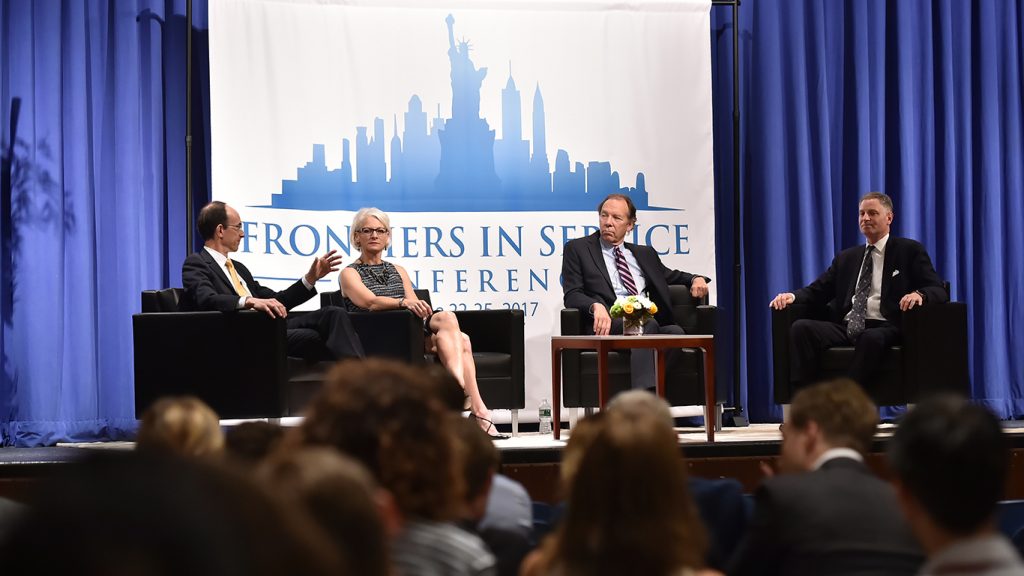From Walmart’s curbside grocery pickup services for those on the go to Airbnb’s recent pilot feature allowing travelers to split payments, companies across the world are adapting to meet consumers’ ever-changing needs.
At the 2017 Frontiers in Service conference, held from June 22 to 25 at the Lincoln Center campus, high-ranking CEOs, service-marketing experts, and academic researchers provided insights on how practitioners can prepare for new challenges in service management as the industry evolves.
Sponsored by the Gabelli School of Business, the conference, founded in 1992 by University of Maryland business professor Roland Rust, featured keynote speakers, paper presentations, and poster sessions. It covered a range of topics, including service human resources, technology-based service innovations, customer engagement, and service marketing.

“This conference aligns three of our strategic differentiators, which are [focused]around social innovation, services and services research, and industry connectivity,” said Donna Rapaccioli, Ph.D., dean of the Gabelli School, in her welcoming remarks.
Stephen Freedman, Ph.D., provost of the University, said service research at its core is about providing managers with the knowledge, skills, tools, and passion to make a difference in the lives of customers and society as a whole.
“Fordham University has the same ideals that we try to instill in each and every one of our students,” he said.
The CEO’s guide to superior customer service
A plenary session, moderated by Robert Reiss of the CEO Forum, featured executives from three highly recognizable brands: Adam Goldstein, president and COO of Royal Caribbean Cruises, Sharon Price John, CEO of Build-A-Bear Workshop, makers of teddy bears, and Dan Hesse, former CEO of Sprint.
The executives said good customer service is the driver behind all of their successes.
Royal Caribbean Cruises offers everything from Tony award-winning productions to a sky-diving stimulator, said Goldstein. He has had to juggle the need to offer a whole new line of features, amenities, and customer interactions while also sustaining customer service excellence.
“We had to reposition our offering in a way that would convince people who take vacations to try vacations on the water, and that is not a trivial thing,” he said.
Price John said that Build-A-Bear does more that just produce stuffed animals for young consumers and their families. It has personalized its services to build emotional connections between its products and those consumers.
She cites as one example the company’s trademark “heart ceremony,” where children select a heart-shaped material, warm it in their hands, whisper a wish and seal it with a kiss, and place it inside their “furry friend.”
“It is those 160 million emotional moments that have given us permission to understand what we really mean to people, and what we really mean [to people]is love, friendship, and memories,” she said.
Hesse said that when he served as CEO of Sprint from 2007-2014, one of his main priorities was creating a customer service-driven culture. That meant reducing calls to its customer service centers, creating accountabilities within the organization to improve customer experience, and offering one-on-one training with consumers on how to use features on their smartphones. Sprint also offered users innovative unlimited use plans to improve customer satisfaction. The company was later recognized by the American Customer Satisfaction Index as the most-improved U.S. company in customer satisfaction, across all 43 industries.
“Our customers became our advocates,” said Hesse.
With the broadcasting on social media of customer service mishaps like a passenger being dragged off a United Airlines flight earlier this year, Hesse said technology is changing businesses’ relationships with their customers.
“You can’t hide anymore,” he said. “Someone has got it on film, and it can be tremendously beneficial or a big problem in terms of customer care.”
Price John said she helped to launch new Build-A-Bear multimedia and virtual product lines like Promise Pets and Honey Girls, coupling technology with a content plan to create new revenue streams, drive consumer engagement, and increase profits.
“[Consumers] want to experience Build-A-Bear in a number of different channels.”
Goldstein said knowing when to pivot and how to use technology to simplify services and create better customer experiences is critical.
“There is no way to provide acceptable—nevermind award-winning—customer service in the next 50 years, without taking full advantage of mobility and data,” he said.


